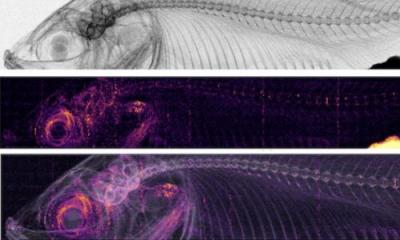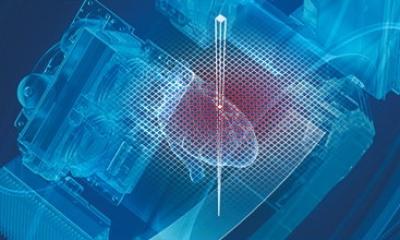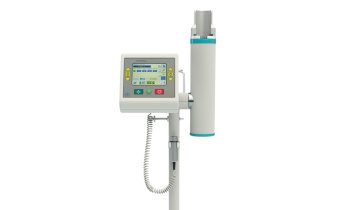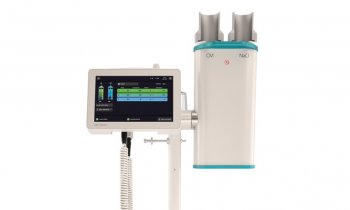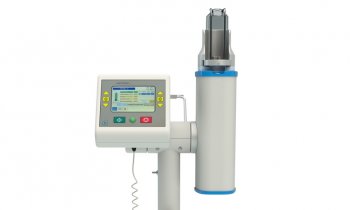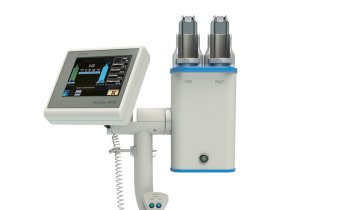Diagnosing from a distance
An echocardiography system that conveniently slips into a coat pocket, this kind of miniature device is now commercially available. Portable ultrasound has been around for about a decade, but until recently the machines were about the size of a laptop rather than that of a smart-phone

Sirsa, India – 250 km northeast of Delhi. Twelve million men, women and children have gathered for the DeraSachaSauda meditation camp. However, meditation is not the only technique that participants employ to care for themselves ¬¬– more than 1,000 people also preregistered to undergo cardiovascular screening using a pocket echocardiography device. While the patients in this remote rural Indian district await examination by a team of American radiographers and cardiologists, 75 physician volunteers in the USA, Canada, Bulgaria, Georgia, and Saudi Arabia stand ready in their respective time zones to read the incoming images.
Organised by Dr ParthoSengupta from Mount Sinai School of Medicine, New York, and physicians at MedantaMedicity, in March 2012 the examinations in Sirsa were part of one of the largest trials carried out with miniature ultrasound – and highlights the technology’s promise for application in the developing world.
No substitute for full echo
As the study carried out in India shows, one of the most promising areas of application of the miniature echocardiography machines are remote places, which previously havehad no access to this technology. ‘The image quality rendered by the device is average and it lacks spectral Doppler imaging capability,’ explains Jens-Uwe Voigt, Professor of Cardiology at the University of Leuven. Voigt co-authored a study comparing the pocket echo to the gold standard, i.e. the full-featured system. Compared with the gold-standard full-featured system, the pocket device underestimated, for example, aortic-stenosis severity in half of the patients. Nevertheless, Voigt and his co-author Dr Christian Prinz concluded it was ‘possible to perform adequate imaging and quantitative assessment of heart function in every case of our study population’.
Distinguishing between the diverse ways in which the new technology can be used is important. Just relying on the image visible on the pocket-sized device itself can serve a number of important purposes, even though it cannot replace a complete echo exam. ‘A pocket-sized echo device allows initial assessment of ventricular and valvular function, pericardial and pleural effusion or extravascular lung water,’ explains Dr Ivan Stankovic, who spoke on this topic at the ESC conference in Munich.
All these features may be useful in different clinical scenarios, from emergency settings, for example, to rule out cardiac tamponade. Another application is the standard physical examination, enabling a physician to rule out depressed left ventricular ejection fraction in a patient with exertional shortness of breath, for instance. In this way, the devices may be useful even in well-equipped hospitals since they can solve certain clinical questions on the spot, Prof. Voigt adds.
Sending images from Honduras
‘When full echocardiography is not available, images obtained with pocket-sized devices can be extremely valuable,‘says Dr Stankovic. He emphasises the fact that echocardiography is a highly operator dependent technique and the level of knowledge and training of the echocardiographer plays a major role in establishing an accurate diagnosis. Hence, the combination of obtaining images with pocket-sized devices and expert interpretation, as in Sirsa, has great potential for diagnosing patients who have never had access to echocardiography before.
Dr Stankovic points to a study carried by Choi et al. The results were published under the title ‘Interpretation of Remotely Downloaded Pocket-Size Cardiac Ultrasound Images on a Web-Enabled Smartphone: Validation against Workstation Evaluation’ in the Journal of the American Society of Echocardiography in December 2011. The study was to test the hypothesis that remote interpretation on a smartphone with dedicated medical imaging software can be as accurate as on a workstation.’
Eighty-nine patients in a remote Honduran village underwent echocardiography by a non-expert using a pocket-size ultrasound device. Images were sent for verification of point-of-care diagnosis to two expert echo cardiographers in the USA reading on a workstation. The author of the study concluded that they‘found that expert interpretation of echocardiograms on a smartphone has minimal loss of accuracy over traditional workstation methods’.
Clear questions are rare
There are, however, several important limitations to take into account. Transmission of data over the public internet raises questions about data privacy, if there is a possibility to connect to the World Wide Web at all. This might often not be the case in remote rural settings. The study carried out in Honduras came with other important limitations, too. The authors point out that ‘the indications for echocardiographic evaluation were heavily weighted toward arrhythmia, cardiomyopathy and syncope, indicative of the nature of cardiovascular disease in rural Honduras, where Chagas disease is endemic.’
In Europe and the US, many pocket size devices have already found their way into ‘many white coat pockets’, Dr Stankovic says. Pocket-sized echo devices are used by general practitioners, internal and emergency medicine specialists, anaesthesiologists, and other medical professionals. ‘There is a risk that widespread use of pocket-sized devices by non-experts lead to a rising number of inaccurate diagnoses or lull patients into a false sense of security,’he points out. While the small devices are useful to exclude major cardiac pathology mentioned above, it is not often the case that patients are referred with a clear diagnostic question. More often than not, patients come in with nonspecific complaints, such as light-headedness or shortness of breath, for which there are a large number of possible causes and then it needs the expertise of a cardiologist to find an explanation.
Thorough training is necessary
While accredited echo cardiographers don’t need additional training to use pocket imaging devices, other medical professional should undergo at least basic echocardiographic training. The European Association of Echocardiography (EAE) is developing a certified training to fill exactly this gap. Professor Voigt leads the committee in charge of developing the training.
‘The training consists of a combination of online and practical modules,’ he explains. Physicians interested in using a pocket-sized device will first acquire the basic knowledge via the online module. After they have successfully demonstrated their knowledge ina multiple choice test, they must spend a number of days in an accredited echocardiography laboratory, shadowing an expert and eventually delivering their own diagnosis for a pre-defined number of cases.
Jens-Uwe Voigt studied medicine in Germany, the UK and USA and is professor of cardiology at the department of Cardiovascular Diseases of the university hospital Leuven, Belgium. He heads the echocardiographic laboratory and a science group for non-invasive diagnostics, which focuses on image based methods of metering the myocardfunction. He also initiated and runs the reference laboratory for different European multicenter studies.
The professor is a board member and head of the further education commission of the European Association of Cardiovascular Imaging, fellow of ESC and a member of the German and Belgian Societies for Cardiology, and has edited several echocardiographic textbooks and international guidelines.
Ivan Stankovicgraduated from the Faculty of Medicine, University of Belgrade in 2005 and,following postgraduate studies in Advanced Medical Imaging, from the Catholic University Leuven in 2012. He then became an internal medicine resident at the Department of Cardiology, Clinical Hospital Centre Zemun, Belgrade, Serbia, and is now a research fellow at the Medical Imaging Research Centre, University Hospital Gasthuisberg, Leuven, Belgium.
In 2011,Dr Stankovic was the Research Grant Winner of EAE. His special interests lie in advanced echocardiographic techniques, emergency and stress echocardiography.
24.11.2012




